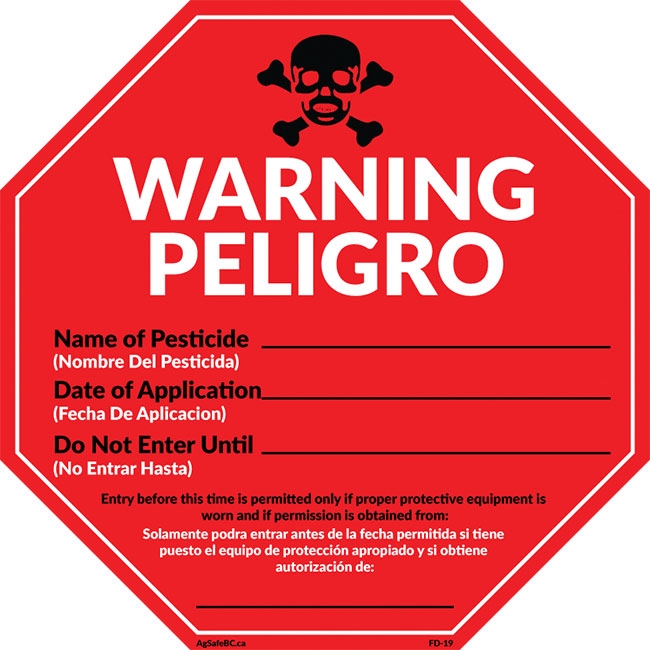
Features
Crop Protection
Inputs
How safe is your pesticide program?
While chemical pesticides may be used on a less frequent basis, worker safety should still be an essential part to any greenhouse IPM program.
October 1, 2019 By TJ Garcha
 Pesticide re-entry signs indicate when workers can return to the workspace following chemical pesticide application.
Pesticide re-entry signs indicate when workers can return to the workspace following chemical pesticide application. The control of pests is essential for greenhouse growers. Most implement an integrated pest management (IPM) program, incorporating both biological and chemical pesticide use.
In truth, any product, biological or chemical, applied to a crop to control a pest is called a pesticide.
Using biological pesticides – the introduction of predatory insects (“good bugs”) to eliminate the pests (“bad bugs”) – reduces health and safety risks for greenhouse workers.
In the case of chemical pesticides, worker safety is a critical part of a greenhouse’s pest management program. Measures must be taken to address hazards and protect worker health and safety whenever and wherever a worker handles or works near chemical pesticides. This is crucial for enclosed environments like greenhouses, because there is less natural air circulation and ventilation which can result in increased and prolonged exposure.
There is a common perception that chemical pesticides only kill pests and do not harm humans. This is false. AgSafe works with growers to help them understand the real dangers and ensure that worker safety is part of their operating pest management program.
Know the risks of exposure
There are three main ways that a chemical, no matter how diluted, can enter the body – absorption through skin, inhalation or ingestion.
Many workers don’t think that they have to take precautions or wear protection until they begin spraying the mixture. In fact, the risk of exposure begins as soon as the container is opened and the mixing process begins. Chemical pesticides are at their most toxic when in concentrated form.
Personal care is extremely important when working with chemicals. Do not be complacent about washing hands and exposed skin after applying chemical pesticides, even if you are only taking a break. Always wash your hands before you eat or drink anything.
Transfer of chemicals from clothing is common. Keep the clothing and personal protective equipment (PPE), such as Tyvek suits and gloves worn during application, separate from non-work clothes and clean immediately after use. Do not wear contaminated clothes home at the end of the day or you could risk exposing your family or others to the chemicals.
Follow the hierarchy of controls
Following the hierarchy of controls is always best. This system was established to minimize exposure to health hazards, where each step is listed in decreasing order of effectiveness. The process can be adapted to meet the needs of a specific situation:
- Elimination, the first step in the hierarchy, is usually not a viable option when implementing an integrated pest management system.
- Substituting the product can be an effective option. Check with your supplier to see if there is an alternative pesticide that is safer or if an option exists for biological control.
- Engineering controls can support other control methods. For greenhouses, include sufficient ventilation during and after chemical pesticide application.
- Administrative controls address when, where, and for how long the application will occur. You can restrict the duration of application, remove other workers from close proximity to spraying, and post safety data sheets (SDS) that identify the chemical, toxicological properties and treatment measures. Enforcing pesticide re-entry intervals (REIs) helps determine when workers can return to the greenhouse after chemical pesticide applications, avoiding any exposure to residues left behind. No one may enter the environment until the required time has lapsed. Recommended REIs are on the container label and should appear on your SDS.
Pesticides must not be kept in areas where food is prepared or stored. Store chemical pesticides in a secure, cool, dry, ventilated facility or shed far away from barns, houses, and other work areas. - PPE is the most commonly used control method – rubber gloves, respirators, chemical-resistant body protection such as Tyvek body suits, and eye protection. Greenhouse workers should familiarize themselves with SDS for specific safety precautions that address the hazards of pesticide absorption, inhalation and ingestion.
Keep up with the latest
Staying on top of the latest products, their uses and alternatives is important to maintaining an effective IPM program. Make a practice of the following:
- Always review container labels and follow mixing instructions for chemical pesticides, and never mix with expired product, other chemicals or agents to extend coverage.
- Research the safest and best pesticide for your purpose.
- Communicate with your local agricultural associations about product updates and suppliers. Associations are a good resource for the latest product research, such as the BC Greenhouse Growers’ Association.
- Utilize local safety resources like AgSafeBC.
- Utilize online regulatory resources – In B.C. you can contact WorkSafeBC.
TJ Garcha is the senior safety advisor at AgSafe, the health and safety association for agricultural employers in British Columbia. The role of AgSafe safety advisors and consultants is to provide workplace safety education and advice, helping achieve long-term safety goals.
Print this page